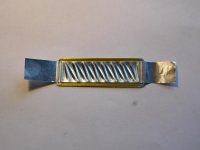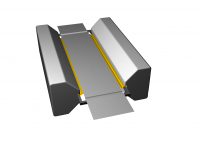Hi, would you have an FRD file for this tweeter that you would share please
You can use VituixCAD SPL Trace to capture from graph. Note that measurements are to half space which is not equal to response in typical box.
Seas_27TBFC_G.frd
Seas_27TBFC_G.frd
You can use VituixCAD SPL Trace to capture from graph. Note that measurements are to half space which is not equal to response in typical box.
Seas_27TBFC_G.frd
Hi, Kimmosto; I have tried but the graph image is so poor that when I erase the grid lines the trace breaks up and the three traces seem to merge
You can use VituixCAD SPL Trace to capture from graph. Note that measurements are to half space which is not equal to response in typical box.
Seas_27TBFC_G.frd
thanks for this, I just noticed the link
The measurements of SB Acoustics SB20PFC30-4 woofer have been added:
SB Acoustics SB20PFC30-4 | HiFiCompass
SB Acoustics SB20PFC30-4 | HiFiCompass
The measurements of SB Acoustics SB20PFC30-8 woofer have been added:
SB Acoustics SB20PFC30-8 | HiFiCompass
SB Acoustics SB20PFC30-8 | HiFiCompass
-it's weird that the extreme low freq. harmonic distortion between the 4 and 8 ohm SB Acoustics differs as much as they do.
That's usually mostly driver compliance (spider and surround) - particularly as you move below fs, and yet (as you would expect) they are very similar.
(..head-scratcher.)
Anyway, very nice additions!
..the Viawave is kind of a "yawn" product.
-might want to look into this manufacturer:
BZ New Audio Lab
That's usually mostly driver compliance (spider and surround) - particularly as you move below fs, and yet (as you would expect) they are very similar.
(..head-scratcher.)
Anyway, very nice additions!
..the Viawave is kind of a "yawn" product.
-might want to look into this manufacturer:
BZ New Audio Lab
Last edited:
The SB20PFC30-4 and SB20PFC30-8 in the 20-200 Hz range are VERY similar. To compare them you should take a look at "THD at 20 mm diagrams".
You made your decision based on THD at 315 mm diagrams which are reliable from 200 Hz and higher up only.
Please, read the comments how to interpret measurements at this page:
Measurements and compare | HiFiCompass
The comments are over the table.
The difference in THD 315 diagrams can be due additional HPF with cutoff 50 Hz was "ON" when measuring one of drivers, I should to check it.
In general, you shouldn't to look at range under 100 Hz in " THD at 315 mm" at all[emoji5]
You made your decision based on THD at 315 mm diagrams which are reliable from 200 Hz and higher up only.
Please, read the comments how to interpret measurements at this page:
Measurements and compare | HiFiCompass
The comments are over the table.
The difference in THD 315 diagrams can be due additional HPF with cutoff 50 Hz was "ON" when measuring one of drivers, I should to check it.
In general, you shouldn't to look at range under 100 Hz in " THD at 315 mm" at all[emoji5]
...the Viawave is kind of a "yawn" product.
...
Care to elaborate ?
You made your decision based on THD at 315 mm diagrams which are reliable from 200 Hz and higher up only.
Ah..
(..I really need to look more carefully.)
Care to elaborate ?
It's fairly standard application performance for a ribbon tweeter of its size, and its size is pretty standard.
Within that context it is excellent (linear decay in particular), but that's still very limited for the typical hobbyist application. (..basically upper 2-3 kHz or more for the high-pass, and a fairly steep filter at that - something most hobbyists aren't that interested in and aren't likely to successfully blend to a larger diaphragm driver.)
Now the GRT145.. that's interesting, but then so is at least one of the Chinese tweeters I linked to. (..and they have very similar construction.)
..and none of the above isn't to say I wouldn't recommend the RT850: pair it with a small enough good midrange and it becomes very interesting.
Last edited:
It's fairly standard application performance for a ribbon tweeter of its size, and its size is pretty standard.
Within that context it is excellent (linear decay in particular), but that's still very limited for the typical hobbyist application. (..basically upper 2-3 kHz or more for the high-pass, and a fairly steep filter at that - something most hobbyists aren't that interested in and aren't likely to successfully blend to a larger diaphragm driver.)
Now the GRT145.. that's interesting, but then so is at least one of the Chinese tweeters I linked to. (..and they have very similar construction.)
..and none of the above isn't to say I wouldn't recommend the RT850: pair it with a small enough good midrange and it becomes very interesting.
Thanks for clarification. I always thought about that tweeter as a ribbon that has a waveguide that is effective down to 3-3,5KHz where i'd let some Ti 4" midrange
I checked that ribbons you've linked. I don't like how they measure - maybe it's because of lousy measuring technique, i wouldn't know.
I'd probably pair the RT850 with a certain tweeter from SB.
-yeah, the ribbons aren't the most linear.. but they do have lower freq. "reach" (..and a fair bit of the linearity irregularity is lower in freq. where the baffle has a lot more influence - and you typically have to deal with it anyway). The larger Viawave has more deviation but err's on the other end of the freq. response (..as is more typical for a ribbon/linesource).
Rick uses them in several of his designs seen here:
Speakers — Selah Audio
..the way he uses the small RAAL ribbon (in the Tempesta Mk2) is what you'd expect for something like the RT850. (..but it's not something most hobbyists would do.)
-yeah, the ribbons aren't the most linear.. but they do have lower freq. "reach" (..and a fair bit of the linearity irregularity is lower in freq. where the baffle has a lot more influence - and you typically have to deal with it anyway). The larger Viawave has more deviation but err's on the other end of the freq. response (..as is more typical for a ribbon/linesource).
Rick uses them in several of his designs seen here:
Speakers — Selah Audio
..the way he uses the small RAAL ribbon (in the Tempesta Mk2) is what you'd expect for something like the RT850. (..but it's not something most hobbyists would do.)
The updated measurements of ScanSpeak 10F/4424G00 have been added:
ScanSpeak 10F/4424G00 | HiFiCompass
It is recommended to clean a browser cache to viewing measurements correctly.
ScanSpeak 10F/4424G00 | HiFiCompass
It is recommended to clean a browser cache to viewing measurements correctly.
Thank you very much. I've been interested in that driver for a project and wondered how it performed.The updated measurements of ScanSpeak 10F/4424G00 have been added:
Now the GRT145.. that's interesting, but then so is at least one of the Chinese tweeters I linked to. (..and they have very similar construction.)
GRT-145 is a real ribbon tweeter.
Here is a photo of a ribbon cartridge. In this tweeter, the ribbon is the radiator and conductor at the same time, as in the classical ribbon.
Attachments
Last edited:
OK, so suspension is similar, yet the Chinese design is more like a "direct radiator", and the GRT-145 is a ribbon.
It explains the differences in efficiency and the higher spl with the rising frequency.
Your GRT-145 looks "ripe" for a larger waveguide/horn - with good extension and resulting higher efficiency, and very low resulting distortion. ..at that point you would seriously have to ask what a good treble compression driver was needed for. Hint.. Hint.. -this niche needs filling!
It explains the differences in efficiency and the higher spl with the rising frequency.
Your GRT-145 looks "ripe" for a larger waveguide/horn - with good extension and resulting higher efficiency, and very low resulting distortion. ..at that point you would seriously have to ask what a good treble compression driver was needed for. Hint.. Hint.. -this niche needs filling!
Last edited:
- Home
- Loudspeakers
- Multi-Way
- Some speaker driver measurements...

